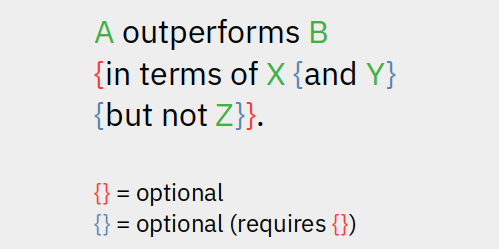|
This site is still under construction. Check back often to see updates. If you have any suggestions, use the contact form. |
Comparisons
Papers typically have many comparison statements (e.g., those comparing the proposed method to existing methods). The most common problems I have seen are:
-
It’s not clear what is being compared (see Comparison is relative).
-
Quantities being compared are not like quantities (see Comparison of like quantities).
This section shows you how to avoid these problems and gives you common patterns that you can use throughout your paper.
Common comparisons
For two like quantities A and B (i.e., quantities A and B are of the same type; see Comparison of like quantities), the following comparisons can be made.
| Case | Comparison statement |
|---|---|
A = B |
A is equal to B. |
A != B |
A is not equal to B. |
A > B |
A is higher than B. |
A < B |
A is lower than B. |
A ≥ B |
A is higher than or equal to B. |
A ≤ B |
A is lower than or equal to B. |
| Case | Comparison statement |
|---|---|
PA = PB |
A has the same P as that of B. |
PA != PB |
A has a different P from that of B. |
PA > PB |
A has a higher P than that of B. |
PA < PB |
A has a lower P than that of B. |
PA ≥ PB |
A has the same or higher P compared with that of B. |
PA ≤ PB |
A has the same or lower P compared with that of B. |
"higher"/"lower" should be replaced by "stronger"/"weaker", "lighter"/"heavier", etc. where necessary. Note that for "PA ≥ PB" and "PA ≤ PB", "compared with" is used because "the same" requires "as" ("the same as") whereas "higher/lower" requires "than" ("higher/lower than").
Similarity
"similar to" is used to express similarity. Three common patterns are listed below.
Pattern 1 |
Item 1 has X similar to that of item 2. |
Pattern 2 |
Item 1 has similar X to that of item 2. |
Pattern 3 |
X of item 2 is similar to that of item 2. |
Degrees of difference
The difference between A and B can be small or large.
| Case | Comparison (A first) | Comparison (B first) |
|---|---|---|
A = 30, B = 50 |
A is lower than B. |
B is higher than A. |
A = 30, B = 35 |
A is slighly lower than B. |
B is slightly higher than A. |
A = 30, B = 90 |
A is much lower than B. |
B is much higher than A. |
A = 30, B = 31 |
A is almost equal to B. |
B is almost equal to A. |
Comparison is relative
A comparison requires at least two quantities or items.
|
|
A is higher than B. |
|
|
C outperforms D. |
"A is higher" is sufficient if the preceding text makes it clear what is being compared. This is often not the case. Do not rely on implied comparisons. The reader should not have to guess the two quantities or items being compared.
Example 2. Common mistake.
|
Comparison of like quantities
A comparison must compare like quantities (i.e., quantities that are of the same type). For example, temperature must be compared with temperature and velocity must be compared with velocity.
Incorrect comparisons are probably the most common mistake that I correct.
Example 3. Incorrect comparisons (unlike quantities)
|
Example 4. "that of" and "those of"
|
Comparison of performance
Proposed methods are commonly compared with existing methods.
A useful structure for such comparisons is shown in Figure 1.

|
|
Our method outperforms state-of-the-art methods. |
|
|
Our method outperforms state-of-the-art methods in terms of accuracy. |
|
|
Our method outperforms state-of-the-art methods in terms of accuracy, but not computation time. |